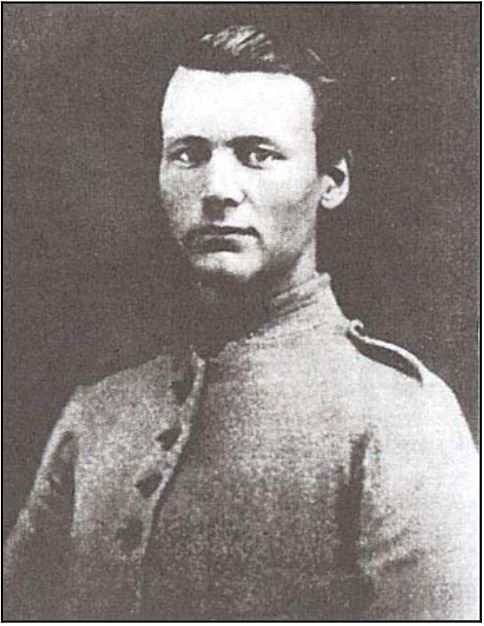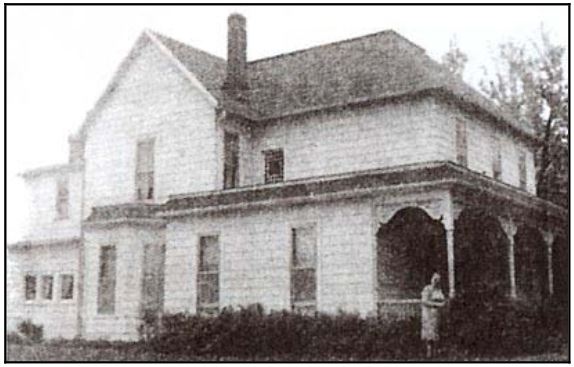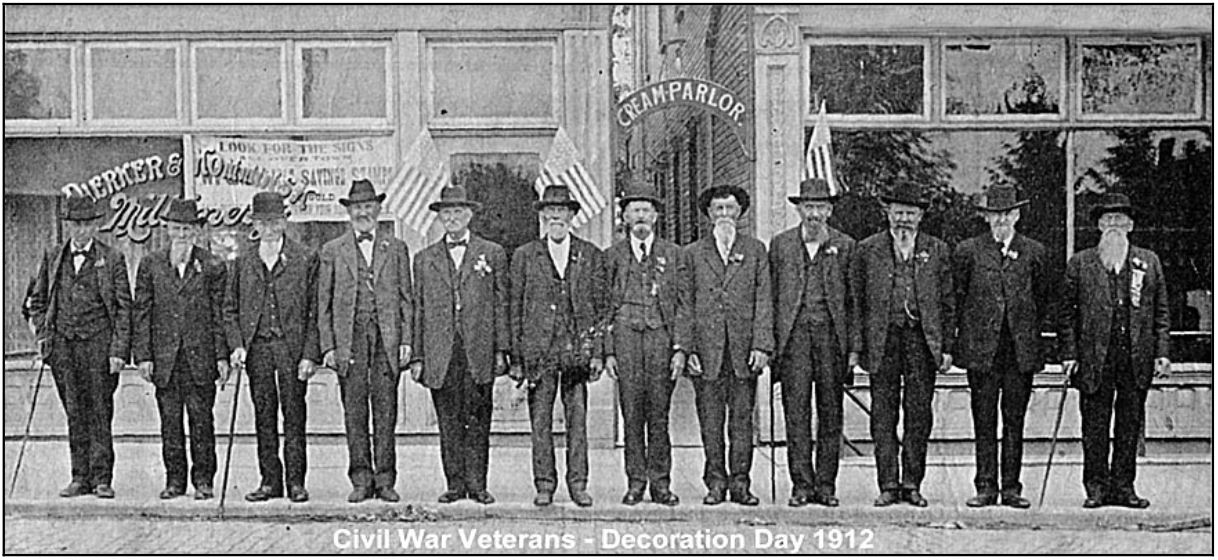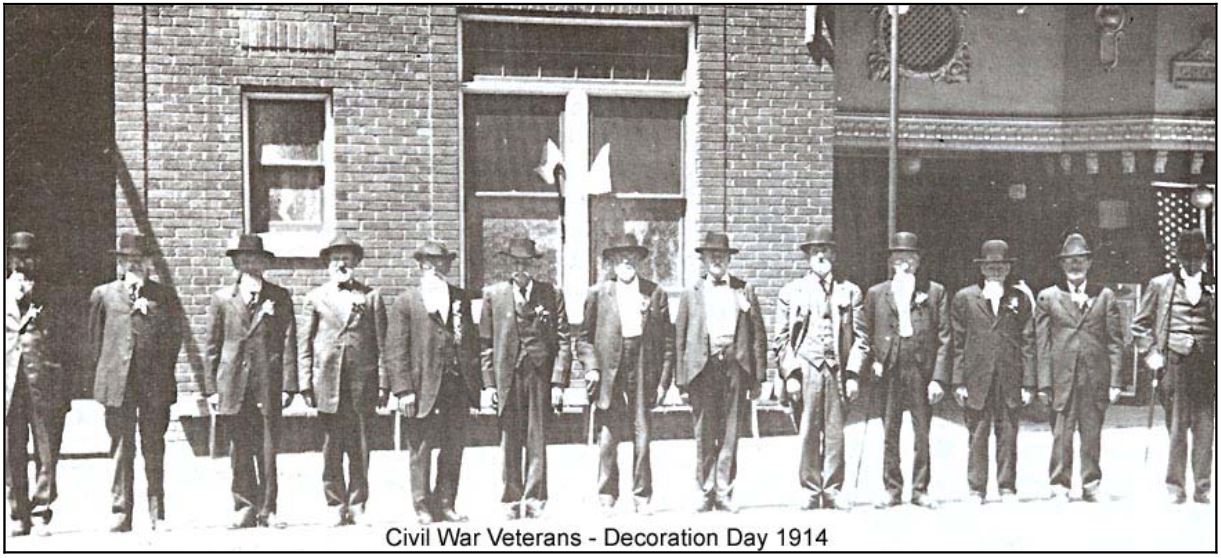No products
Civil War Stories and Anecdotes
Captain Michael Stone
Captain Michael Stone
Michael Stone was born May 4, 1841, the son of Thomas Stone of Ireland and Eliza Wise of Pennsylvania. He was reared in St. Marys, Ohio.
On April 17, 1861, just weeks before his 20th birthday, Michael Stone enlisted in Co. "E", 20th Ohio Volunteer Infantry, at St. Marys, his home town. On April 27th, he was elected 1st Sergeant. Company "E" was sent to Zanesville, Ohio, where the men were mustered in as Ohio troops under President Lincoln's call for men to join the State Militia for 90 days.
In early June, 1861, the 20th O.V.I. left Camp Goddard at Zanesville and went via the Central Ohio Railroad to Bellaire where they crossed the Ohio River to Benwood, Virginia (later West Virginia.)
On August 10, 1861, Michael Stone mustered out of the Militia, & on August 18th, he enlisted in the re-formed 20th O.V.I. for 3 years service with the Federal Army.
On September 3, 1861, Stone was appointed 1st Lieutenant in the 31st Ohio Volunteer Infantry, Co. "C". On September 27th, the 31st O.V.I. traveled to Cincinnati, then via railroad to Louisville, Kentucky, and then to Camp Dick Robinson south of Lexington.
On February 26, 1862, Michael Stone was promoted to Captain of Co. "G" of the 31st O.V.I. at Louisville.
On June 19, 1864, at Kenesaw Mountain, near Atlanta, with skirmishers being ordered to the front, two companies under the command of Captains Wade and Stone advanced to the edge of a piece of woods and soon became engaged with the enemy's skirmishers. The regiment was ordered to support them, and four companies were advanced to the edge of an open field in which the deployed line had been imprudently halted by an officer and the inspector of the 2nd Brigade. So dangerous did their position become that it was only by the personal gallantry of Captain Stone, acting as Major, that his men could be supplied with ammunition.
On July 20, 1864, Capt. Stone was again cited when, acting as a field officer, he gallantly led Co. "G" forward as skirmishers, and soon disclosed the enemy's position.
On the morning of August 5, 1864, the skirmish line, having been strengthened to 150 men, was ordered to advance and endeavor to capture the enemy's rifle-pits. Captain Stone, brigade officer of the day, having arranged a plan of attack, moved forward his line until within 100 yards of the enemy. At the bugle-call, in conjunction with the skirmishers of the other brigades of the 3rd Division, they dashed into the rifle-pits and captured 2 commissioned officers and 54 enlisted men. Only one man was killed and 3 were wounded, a result mainly owing to the skill, coolness, and daring bravery of Capt. Stone, acting as Major.
On August 7, 1864, Capt. Stone was slightly wounded in the mouth and spent 2 weeks in the hospital at Atlanta.
On March 12, 1865, Capt. Stone's 3-year enlistment was up, and he was discharged at Fayetteville, N.C. as active commander of the 31st O.V.I. His discharge paper states that he was enrolled on March 6, 1862 to serve "three years or during the war." It also states that he was born in Auglaize County, was 23 years of age, 5'9" high, had a light complexion, blue eyes, and brown hair. His occupation upon enrollment was listed as carpenter.
The 31st O.V.I. went on to the end of the war and was mustered out July 20, 1865 at Camp Chase at Columbus. Stone was mustered into Kishler Post #83 of the G.A.R. in St. Marys on 11/13/1882.
A more detailed "time line" of the movements, battles, and operations of Capt. Michael Stone's regiment from April, 1861 through July, 1865 as compiled by his grandson, Judge Jacob J. Boesel, can be seen at the N.B. Public Library.
DR. MICHAEL STONE
After Captain Michael Stone was discharged from the 31st O.V.I., he returned home to St. Marys and entered the study of medicine. He married Mary Magdalene Elzey at Decatur, Indiana on September 13, 1876. Mary was born September 16, 1851 on a farm near Decatur.
Dr. & Mrs. Stone had four children, the three oldest being born in New Corydon, Indiana: Thomas W. (10/4/1877-9/27/1933), who married Dorothea Gilberg of New Bremen; Maud (1878?-11/28/1918), who married Attorney Theodore Tangeman; Bessie Lee (4/13/1881- 3/19/1958), who married Attorney Otto J. Boesel; and Margaret Cleo ("Tuttie"), who graduated with the class of 1909 and served as associate editor of the first N.B.H.S. yearbook ("Mirage") ever published. She later married Al K. Kinley, lived in Cleveland, and died in the mid-1930s.
Dr. Stone practiced medicine for 5 years at New Corydon, Indiana, then at St. Marys and Coldwater before the family moved to New Bremen on December 2, 1884.
In October, 1890, Dr. Stone purchased the first lot on the east side of South Main St., south of the alley behind the businesses on Monroe St. By July, 1891, the Stones had built a new 2-story frame house on this lot. Next to it, August Dierker was building his 2-story brick house, and south of that, Fred Pohlman was also building a 2-story frame house. This marked the opening up of the Fred Vogelsang addition and the extension of S. Main St.
The three oldest Stone children were all school teachers - Thomas at Kettlersville and Maud & Bessie in New Bremen. In 1902, Thomas received a degree in mechanical engineering from Ohio State University after which he became associated with the Western Gas Engineering Co. in Fort Wayne, Indiana and eventually became its vice-president and general manager. In August, 1900, "Miss Maud" purchased a millinery store from Theodore Rabe on S. Washington St. and she and Bessie ran this until both married in 1906 and sold it to Mrs. E.R. Haines. Their husbands were attorneys and had their business together above the Arcade at that time.
Dr. Michael Stone died May 17, 1898 at his home on S. Main St. of chronic gastritis and stricture of the pyloric end of the stomach, a condition he was thought to have contracted while in the Civil War. He was buried in Elm Grove Cemetery at St. Marys, near the grave of his father, Thomas Stone, who had died on March 15, 1881. Mary (Elzey) Stone lived until September 3, 1928.
Other doctors who practiced in the former Dr. Stone office at 8 North Main St. were Dr. P. Radabaugh (January, 1895), *Dr. William H. Fesker (March, 1901), and Dr. E.M. Phelps of St. Marys (January, 1903.) The Stones' house was later turned into three apartments and was owned by Mrs. Freda Koenig. It was purchased several years ago by Crown Equipment Corp. and razed.
Dr. Michael Stone's Home
10 S. Main Street
DR. WILLIAM H. FESKER*
(3/3/1874-6/4/1902)
Dr. Wm. H. Fesker was a veteran of the Spanish- American War. He graduated from Cincinnati's Ohio Medical College in March, 1900 and came to N.B. in March, 1901. On October 12, 1901, he married Bertha Wiemeyer of New Bremen. His medical practice was very short lived as he died on June 4, 1902 at the age of 28.
CIVIL WAR MILITARY RECORD
Soon after the telegraph brought the news of the Rebels' 4/12/1861 attack on Fort Sumter, S.C., the whole state of Ohio rallied to the defense of the Union. The U.S. Army at that time consisted of fewer than 17,000 troops. On April 15th, President Lincoln called upon the states and territories for 75,000 militiamen, each to serve for 90 days. Ohio's quota was 13,000 but 30,000 responded.
In Auglaize County, the work of enlisting men and the organization of companies was started. Recruiting officers from Camps Vance (near Findlay), Cleveland, Chase (in Columbus), Troy, and Lima opened offices in different localities in the county. On the evening of 4/22/1861, a meeting was held at the courthouse at Wapakoneta and the call was made for volunteers. Some 60 men came forward and signed the roll and took the oath. As the days passed, others came forward to do the same.
After the Union Army was turned back on July 21, 1861, at Bull Run Creek / Manassas Junction, Virginia, in the first battle of the war, President Lincoln called for the enlistment of 100,000 additional troops to serve for 3 years instead of 3 months. Before this, both sides thought the other would collapse within 90 days.
Before the close of the war, over 1100 men from Auglaize County had entered the service of the Army. In all, Ohio furnished 340,000 soldiers - one eighth of all who fought for the Union Army.
STONEWALL JACKSON
It was at the Battle of Bull Run / Manassas that Thomas J. Jackson was given the nickname "Stonewall." He was in command of a Virginia brigade which firmly held a hill at the center of the southern line. Gen. Bernard Bee of S.C. yelled to his own men, "Look, there is Jackson with his Virginians, standing like a stone wall!"
The soldiers of the New Bremen area served mostly in Company "C" of the 37th Regiment of the Ohio Volunteer Infantry. The 37th O.V.I. was the third entirely German regiment organized in the state and came from Auglaize, Mercer, and Wyandot Counties. Company C's men were all from Auglaize County, and nearly all were mustered into service on 9/14/1861 at Camp Brown at Cleveland. At Vicksburg, Mississippi, the Lt. Colonel became severely wounded and the command devolved upon Major Charles Hipp, who later became Postmaster in St. Marys. On 11/13/1864 the regiment entered Atlanta to obtain outfits for the "Grand March to the Sea" under Gen. William T. Sherman. The men were discharged from this regiment at Cleveland, Ohio on 8/12/1865.
The 45th O.V.I. was organized at Camp Chase (Columbus) on 8/19/1862 and had 75 recruits from Auglaize County. It was discharged at Nashville on 6/15/1865.
The 57th O.V.I., Co. "C" was recruited at Findlay from Auglaize, Mercer, and Sandusky Counties.
The 71st O.V.I. was recruited mainly from Auglaize, Mercer and Miami Counties from October, 1861 to February, 1862. It was mustered out at Camp Chase in January, 1866.
The 99th O.V.I. was mustered into service August 26, 1862 and included one company from Auglaize County. Of the 99th's 1700 recruits, 700 were transferred to the 118th O.V.I. The remaining 99th left Camp Lima on August 31st and reported at Lexington, Kentucky. Later, at Nashville, the remnant of the 99th was consolidated with and became known as the 50th O.V.I. and was finally mustered out at Salisbury, N.C. on June 26, 1865.
The 118th O.V.I. was mustered into service at Lima in August, 1862, was ordered to Kentucky, and operated in Kentucky and Tennessee without any particular engagement until the campaign of May, 1864, when, in a single 10-minute charge against Resaca, Georgia, the regiment lost 116 of the 300 men engaged. The regiment was mustered out at Cleveland on July 9, 1865.
CIVIL WAR ERA TIME-LINE
1854 - The Republican party was formed by men opposed to the extension of slavery.
1855-1856 - Warfare in Kansas between slavery and anti-slavery factions. John Brown, a radical abolitionist born in Torrington, Connecticut, led a raid on pro-slavery settlers at Pottawatomie Creek in Kansas, killing five.
1858 - A review of Ohio's military forces was held.
10/16-18/1859 - John Brown and his followers captured the federal arsenal at Harper's Ferry, Virginia (later West Virginia), planning to use the arms to incite a slave revolt in the south. U.S. Marines, led by Lt. Col. Robert E. Lee, forced them to surrender.
12/2/1859 - Convicted of murder and treason against Virginia, John Brown was hanged at Charles Town, Va.
1860 - Republican Abraham Lincoln is elected as the 16th President of the United States. South Carolina is the first state to secede from the Union in protest.
SECEDED | STATE | READMITTED |
12/20/1860 | South Carolina | (7) 6/25/1868 |
| 1/9/1861 | Mississippi | (9) 2/17/1870 |
1/10/1861 | Florida | (4) 6/25/1868 |
1/11/1861 | Alabama | (3) 6/25/1868 |
1/19/1861 | Georgia | (11) 7/15/1870 |
1/26/1861 | Louisiana | (5) 6/25/1868 |
2/23/1861 | Texas | (10) 3/30/1870 |
4/17/1861 | Virginia | (8) 1/1/61870 |
5/6/1861 | Arkansas | (2) 6/22/1868 |
5/20/1861 | North Carolina | (6) 6/25/1868 |
6/8/1861 | Tennessee | (1) 7/24/1866 |
1/29/1861 - Kansas becomes the 34th state.
2/8/1861 - The Confederate states are organized in a convention at Montgomery, Alabama, their first capital. When Virginia seceded from the Union, Richmond became the new capital of the Confederacy.
2/9/1861 - Jefferson Davis is elected President of the Confederate states.
3/4/1861- President Abraham Lincoln is inaugurated.
4/12/1861 - The Civil War begins at 4:30 a.m. - South Carolina's Confederate troops attack federal Fort Sumter at Charleston, South Carolina.
4/14/1861 - Fort Sumter surrenders.
4/15/1861 - President Lincoln calls upon states and territories for 75,000 militiamen to serve for 90 days.
4/17/1861 - Western delegates at Virginia Convention oppose Virginia's secession from the Union.
6/20/1861 - West Virginians choose a governor who is loyal to the Union.
1/1/1863 - President Lincoln signs the Emancipation Proclamation, freeing slaves in areas controlled by the Confederacy.
6/20/1863 - West Virginia becomes the 35th state, separating itself from Virginia.
7/1-3/1863 - General Robert E. Lee invades Pennsylvania, is turned back at Gettysburg by General Meade's Union Army.
10/31/1864 - Nevada becomes the 36th state.
1864 - Ulysses S. Grant becomes the Supreme Commander of the Union Armies. Grant pushed the Confederate Army south into Virginia, while General William T. Sherman advanced from the west to Atlanta, Georgia, on his "Grand March to the Sea".
1864 - Lincoln is elected for a 2nd term as President.
4/9/1865 - Confederate General Robert E. Lee surrenders to Union General Ulysses S. Grant at the Appomattox courthouse in Virginia.
4/14/1865 - President Abraham Lincoln is shot by John Wilkes Booth at Ford's Theater in Washington, D.C. He died the next day.
4/15/1865 - Andrew Johnson is sworn in as the 17th President of the United States.
5/26/1865 - Surrender of the last Confederate army at Shreveport, Louisiana, ending the Civil War.
12/18/1865 - Slavery is abolished by the 13th Amendment to the U.S. constitution.
3/2/1867 - The Reconstruction Act was passed, organizing the southern states into five military districts.
10/18/1867 - Alaska is purchased from Russia for $7.2 million.
5/30/1868 - In this year, Saturday, May 30th was set as the date on which to observe "Decoration Day." This tradition was begun on May 5, 1866 and had been repeated on May 5, 1867. ("The Towpath" - April, 1997)
7/28/1868 - Citizenship was granted to former slaves by the 14th Amendment to the U.S. Constitution.
3/4/1869 - Ulysses S. Grant was inaugurated as the 18th President of the United States.
ULYSSES S. GRANT
Ulysses was born on April 27, 1822 in Point Pleasant, Ohio, the son of Jesse Root and Hannah (Simpson) Grant. His given name at birth was Hiram Ulysses, however he switched it to Ulysses Hiram when still a boy. When he applied for admission to West Point, through a clerical error, he was listed as Ulysses "Simpson" Grant. He accepted this name change and continued to be known thereafter as Ulysses S. Grant.
DIETRICH SCHROEDER
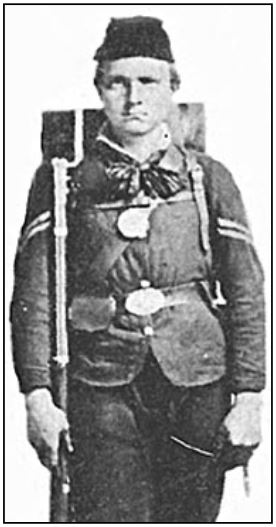
Dietrich was born 12/22/1839 in Germany and emigrated to America in 1854. Prior to enlisting on 9/3/1861 in Co. "C", he had also served 3 months in Co. "E" of the 20th O.V.I. He was promoted to Corporal on 2/9/1862.
Dietrich served in many engagements under the command of Major Charles Hipp of St. Marys, the most noteworthy being the Battle of Missionary Ridge, Tenn., which was inspired and directed by Gen. August Willich of St. Marys, and where, on 11/28/1863, Dietrich was wounded by a shot in the ankle. He was discharged for disability on 12/15/1864 at Camp Dennison. His discharge certificate and examining surgeon's certificate were signed by W.G. Kishler, Examining Surgeon, on 10/30/1865 at St. Marys.
Dietrich was a blacksmith by trade and had been detailed as such during the war. He married Elise Schowe on 3/6/1866. Their home and his blacksmith shop were located near the canal, at 104 E. Plum St. A restored log house now sits at this location, having been moved from Mercer County and reassembled there by Crown Equipment Corp. around 1995. Dietrich was the grandfather of Ralph May, well-known and much-published New Bremen historian.
Dietrich Schroeder died 9/18/1895 and was buried at Willow Grove (Lock 3) Cemetery. His remains were accompanied by his army comrades of New Bremen, St. Marys, and Wapakoneta, and also the Little Six Band of New Bremen. (N.B. Sun - 9/21/1895)
THE G.A.R. ENCAMPMENT
A New Bremenite Tells What He Thinks Of It
(New Bremen Sun - 9/21/1895)
Messrs. William Schulenberg, Henry Finke, and Henry Schaefer attended the big G.A.R. (Grand Army of the Republic) encampment at Louisville, Kentucky last week. Their experiences were related in the following interesting style by William Schulenberg:
"The long advertised encampment of the G.A.R. held at Louisville, Kentucky has come and gone. I have learned from personal experience that those who believed the encampment at Pittsburgh last year made a mistake by selecting any place south of the Ohio River for holding the next encampment, for the reason that many believed the animosity created by the late war still existed between the North and South, are the ones that were mistaken, and upon their arrival had just cause to banish from their minds all thoughts of animosity.
Henry Finke, Henry Schaefer, and myself left New Bremen on Monday morning, September 9th, and were joined at St. Marys by a number of comrades. We took a special train from St. Marys which landed us at Louisville at about 6:00 p.m. without change of cars. Upon our arrival we were greeted on every hand with a hearty welcome. Everyone seemed to battle with each other in extending the hospitality for which Kentucky is noted.
The most noted rebels of bygone days seemed to have nothing on their minds but the atonement for the evil deeds done by them in the past, and well did they redeem themselves. We talked with many old rebels who acknowledged that during the war they hated us worse than rattlesnakes, but that feeling had long ago taken wings and gone.
When we 'visited' them over 30 years ago, they resisted us. Now they welcomed us from the bottom of their hearts and were glad that the war resulted as it did - said that slavery was a curse, but they never knew it until it was abolished. Now no man in the south can be found that would accept it if tendered.
The decorations exceeded anything ever seen - welcome banners everywhere with 'Old Glory' waving over all. Not only the business houses and dwellings were covered from ground to roof, but even the trees were wrapped from root to branch and extended in every direction from the city for 25 miles around on every road entering the city.
We also had the pleasure of forming the acquaintance of Otto Dolphinger and family, relatives of Fred and Henry Künning, where we were made to feel at home almost before we had entered their pleasant and cozy home. They treated us with such cordiality that for the time being we felt like members of the family.
Later, Mr. Dolphinger took us to Cave Hill Cemetery, second finest in the U.S., and the other places of sightseeing. At the cemetery, we visited the graves of the Detchen family, the mother of whom was a sister to Henry and Fred Künning. Everything connected with the encampment was a glorious success, barring accidents with which daily papers have made everyone acquainted. After 3 full days of sightseeing in the Falls city, somewhat fatigued, we started homeward on Friday morning. After breakfasting in Louisville, we took dinner in Indianapolis and visited the soldiers' monument between trains and arrived home for supper nothing the worse for wear."
CIVIL WAR VETERANS IN 1912 DECORATION DAY PARADE
in front of Minnie Dierker & Hilda Komminsk's Millinery Shop & Schulenberg’s Store 5-7 West Monroe St. - New Bremen, Ohio
1. Fred Tellman (6/25/1838-4/15/1916)
2. Herman A. Moeller (10/28/1845-7/5/1918)
3. (unknown - mis-identified*)
4. Henry Schaefer (6/29/1842-10/27/1935)
5. William Tschudin (11/16/1844-4/7/1917)
6. John William Waterman (5/19/1842-6/7/1927
7. Fred Roettger (5/20/1842-1/31/1919)
8. Ben Schulenberg (2/12/1845-7/20/1915)
9. Frederick Dickman (10/25/1833-5/13/1915)
10. William Vornholt (3/2/1838-7/22/1912)
11. Fred Behm (10/11/1844-2/20/1927)
12. William Schulenberg (9/7/1838-1/26/1928)
*Number 3 (above) was mis-identified as "Herman" Hermsmeyer who had served in the Mexican War. (E.Leader-2/11/1971) However, it was Gottlieb Hermsmeyer who served in the Mexican War and he died 6/12/1909. Ralph May identified the men in this 1912 picture as "in their late eighties." Actually they were in their 60s and 70s.
CIVIL WAR VETERANS IN 1914 DECORATION DAY PARADE
in front of the 1912 Laut-Schulenberg / Crown Theater building on the north side of the street across from the Laut (Hollingsworth) Hotel on West Monroe St. - New Bremen, Ohio
(This is a copy of a postcard sent to Civil War Veteran, Fred Dickman, by Herbert Schulenberg, Crown Theater owner.) As far is known, this picture has not been previously published. The veterans were not identified, however many of them are probably the same as in the 1912 picture above, except for William Vornholt, who died on 7/22/1912.


